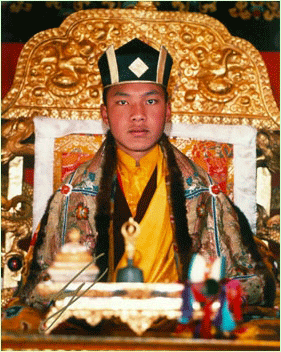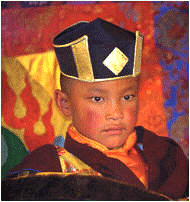His Holiness the Gyalwa Karmapa, Ogyen Trinley Dorje
 “It is not important what makes me, as an individual, smile; it is important what makes humanity smile.
“It is not important what makes me, as an individual, smile; it is important what makes humanity smile.
Humanity smiles the moment our motivations and actions are the same.”
His Holiness the Seventeenth Gyalwa Karmapa, Ogyen Trinley Dorje
Karmapa means “the one who carries out buddha-activity” or “the embodiment of all the activities of the buddhas.” The Karmapas have incarnated in this form of nirmanakaya, or manifestation body, for seventeen lifetimes, as of the present, and all have played the most important role in preserving and propagating the Buddhist teachings of Tibet.
The arrival of a master who would be known as the Karmapa was been prophesied by the historic Buddha Shakyamuni and the great tantric master of India, Guru Padmasambhava. Throughout the centuries, Karmapas have been the central figure in the continuation of the vajrayana lineage in general and Kagyu lineage in particular, and have played a very important role in the preservation of the study and practice lineages of Buddhism.
Historical Background
Il The Lord Buddha Shakyamuni has foretold the coming of the Karmapa in various sutras and tantras. Only a few of the buddhist masters are prophesied in the sutras and tantras and the Karmapa was certainly one of them.
The following prophecies were compiled by Rinchen Palzang and appear in his work entitled The All-Illuminating Mirror:
From the Samadhiraja Sutra (The King of Samadhi Sutra):
Two thousand years after my passing,
The teachings will spread in the land of the red-faced ones,
Who will be the disciples of Avalokita (Chenresi).
[At that time,] the bodhisattva Simhanada, known as “Karmapa”, will appear.
Possessing mastery over samadhi, he will tame beings
And establish them in bliss through seeing, hearing, recalling and touching.
From the Lankavatara Sutra (Descent Into Lanka Sutra):
Wearing monastic robes and a black crown,
He will perform unceasing benefit for beings
Until the teachings of one thousand buddhas disappear.
From the Mulamanjushri Tantra (Root Tantra of Mañjushri):
Endowed with a name beginning with “Ka” and ending with “Ma”,,
There will appear an individual who illuminates the teachings..
The Karmapa’s arrival was also prophesized by the great Indian mahasiddha, Padmasambhava (Guru Rinpoche) in various termas.
The Buddha Karmapa
From the viewpoint of the ultimate essence, it is said that the Karmapa has attained enlightenment long time ago, as a Buddha in the past called Shenphen Namrol. He will be the sixth Buddha of this fortunate eon in the future, who will be known as the Trukpa Senge and he is inseparable with the present buddha, Shakyamuni.
From the relative point of view, he manifests as the tenth level (bhumi) Bodhisattva and an emanation of Avalokiteshvara or Chenrezik. The Karmapas have manifested in countless different emanations through the centuries.
Some of the most prominent manifestations of the Karmapas are the Great Brahmin Saraha and Padmasambhava in India and many other emanations in Tibet, who upheld and propagated the teachings of the Buddha and benefited countless beings all over. However, only one nirmakaya form of the successive incarnations appeared in different times and they all have been the most outstanding master in Tibetan buddhist history.
He is the first lama whose successive reincarnate lines were recognized, and he manifested from the 11th century to continues to manifest today.
The Buddha Activity
The Karmapas have not only played an instrumental role in the Kagyu lineage, but also in other Vajrayana Buddhist schools of Tibet. For example, the Third Karmapa Rangjung Dorje engaged in a key role in the preservation and development of the Nyingthik tradition in the Nyingma lineage; The Fourth Karmapa Rolpe Dorje recognized the outstanding qualities and potential of Je Tsongkhapa and became the first preceptor to Tsongkhapa, the founder of Gelukpa school; the Seventh through the Ninth Karmapas contributed to the preservation and continuation of the Sutras, Tantras, and Mahamudra lineages of the Kagyu school, the Fourteenth Karmapa took part in the preservation and continuation of the Shangpa Kagyu lineage, which was at the brink of becoming extinct, and also had the vision of non-sectarian movement in Tibet, which he encouraged his heart disciple, Jamgon Kongtrul the Great, to continue; the Fifteenth Karmapa Khakhyap Dorje partook in the preservation and continuation of the Terma traditions of the Nyingma lineage; and the Great Sixteenth Gyalwang Karmapa, Rangjung Rigpe Dorje, has been one of the most remarkable Tibetan Buddhist masters of our time, critical to preserving and continuing the various Tibetan buddhist lineages in exile.
His Holiness the Sixteenth Gyalwang Karmapa dedicated a major part of his activity to the preservation of scriptures: staring with the Kagyur, translated words of the Buddha (approx. 108 volumes), and Tengyur, translations of the commentaries to the words of Buddha by the Indian masters (approx. 214 volumes).
His Holiness reprinted the Derge edition in New Delhi and distributed the Kagyur freely to all the Tibetan monasteries in India, Nepal, Bhutan, Tibet, and USA, and Tengyur at the basic costs of printing to all the monasteries. This was a historic deed of His Holiness-no Tibetan masters of the past ever distributed the Kagyur freely to all the monasteries. His Holiness also undertook the work of preserving the writings of great Tibetan masters, including all the works of Karmapas that were available, and propagated them in exile India through teaching, giving transmissions, and printing the scriptures.
His Holiness the Seventeenth Gyalwang Karmapa, Ogyen Trinley Dorje, has been the leading Tibetan master, in the post-1959 era of Tibetan history. His Holiness was the first reincarnate Lama to be recognized by a communist government in the world history. Since then, His Holiness had been a prominent master who contributed to the development of buddhism in Tibet in the 1990’s. During this time, His Holiness rebuilt and fully developed the Tsurphu monastery, the main seat of the Karmapas that was completely destroyed during 1959 and the ’60’s Cultural Revolution.
After many requests – left ignored – for meeting his Root Lama, Tai Situpa, at the end of 1999, His Holiness the Seventeenth Karmapa escaped from Tibet and reached India, where today he lives awaiting permission from the Indian authorities to return to Rumtek Monastery, his traditional exile seat, in Sikkim. From the time of his arrival in India, thousands of Karma Kagyu Lineage practitioners and devotees from all over the world went and visited His Holiness, meeting him during private or public audiences in which His Holiness gives initiations, transmissions and teachings.
One of the special attributes of the Karmapas is the Black Crown, that symbolizes the activity of the direct and unbroken Karmapas’ lineage.
BIOGRAPHY
The Seventeenth Karmapa Ogyen Trinley Dorje
 After his mother had wonderful dreams during her pregnancy, he was born into his nomad family in the Lhatok region of Eastern Tibet in 1985. On the day of his birth, a cuckoo landed on the tent in which he was born, and a mysterious conch-like sound was heard by many throughout the valley.
After his mother had wonderful dreams during her pregnancy, he was born into his nomad family in the Lhatok region of Eastern Tibet in 1985. On the day of his birth, a cuckoo landed on the tent in which he was born, and a mysterious conch-like sound was heard by many throughout the valley.
In Tibet, such events are considered auspicious portents of the birth of an enlightened teacher.
The young nomad, named Apo Gaga, lived a life that seemed, to his family, full of blessing, but Apo Gaga did not reveal to them who he was.
However, in 1992, he asked them to move the location of their nomadic home to another valley, and told them to expect a visit from travelling monks. Soon after setting up their home in the new location, followers of the Sixteenth Karmapa came to that valley pursuant to the secret instructions of the Sixteenth contained in his letter of prediction. The birth and the other details of Apo Gaga’s life matched the predictions of the letter. Apo Gaga was discovered to be the Seventeenth Karmapa, Ogyen Drodul Trinley Dorje.
In addition to his letter of prediction, the Sixteenth Karmapa wrote many poems, or songs, predicting that though he would leave his traditional main seat in Tsurphu, Tibet, he would soon return there, that his root teacher would be HE Situ Rinpoche, and that he would study in India. Furthermore, the predictions of the 19th Century master Chogyur Lingpa matched the details of His Holiness’s birth. These predictions were to be fulfilled, and in this way, it is traditionally said that the Karmapa is”self-recognized.”
The Seventeenth Karmapa did in fact return to Tolung Tsurphu Monastery in Central Tibet in 1992, where he was enthroned on September 27, 1992, with the permission of the Chinese government, a first in Tibet. Over 20,000 supplicants assembled. The following morning, some 25,000 people filed before His Holiness to receive a personal blessing.
At Tsurphu, the Karmapa studied the Buddhist sciences of mind, learned ritual, and practiced sacred arts, such as dance. Each day he received hundreds of visitors from throughout Tibet and around the world. He eventually began to offer empowerments and participated in various rituals at the monastery. At the age of about 10, His Holiness recognized the rebirth of reincarnate teachers, including such eminent teachers as Pawo Rinpoche, Jamgon Kongtrul Rinpoche and the young Dabzang Rinpoche.
While His Holiness was at Tsurphu, the monastery underwent extensive rebuilding to restore the temples, shrines, stupas, a shedra, and residences that had been destroyed over the years, fulfilling one of the main duties of a Karmapa. As the years went by, however, His Holiness came under increasing pressure from Tibetan and Chinese authorities to act in ways which were contrary to his obligations as a Karmapa. He publically refused to denounce the Dalai Lama and to recognize the Panchen Lama, and engaged in numerous other acts which were contrary to the wishes of the authorities.
Finally, in 1999, recognizing perhaps that his usefulness in Tibet was being undermined, he decided to leave. Though he was under constant surveillance from the Chinese government, who refused to let him leave the country, he and a handful of attendants concocted a bold scheme to escape.
After months of careful planning, on December 28, the fourteen-year-old Karmapa pretended to enter into a solitary retreat, and instead, donned civilian garb and slipped out a window. Leaving Tsurphu Monastery with a handful of attendants, he began a daring escape by car, foot, horseback, helicopter, train and taxi, a heroic journey which was to become the stuff of headlines throughout the world.
On January 5, 2000 he arrived, to the the great surprise and overwhelming joy of the world, in Dharamsala, India, where he was met by His Holiness the Fourteenth Dalai Lama. He received refugee status from the government of India in 2001. His Holiness the Karmapa temporarily lives in Sidbhari, in the himalayan state of Himachal Pradesh, in the Gyuto Ramoche monastery, that is two-hours by car from Sherab Ling monastery, where His main Lama, Tai Situ Rinpoche, lives, awaiting permission from the Indian authorities to leave Dharamsala and return to Rumtek Monastery, the traditional seat of the Karmapas in India.
– Source – www.samyedzongvenice.org





Comments are closed.